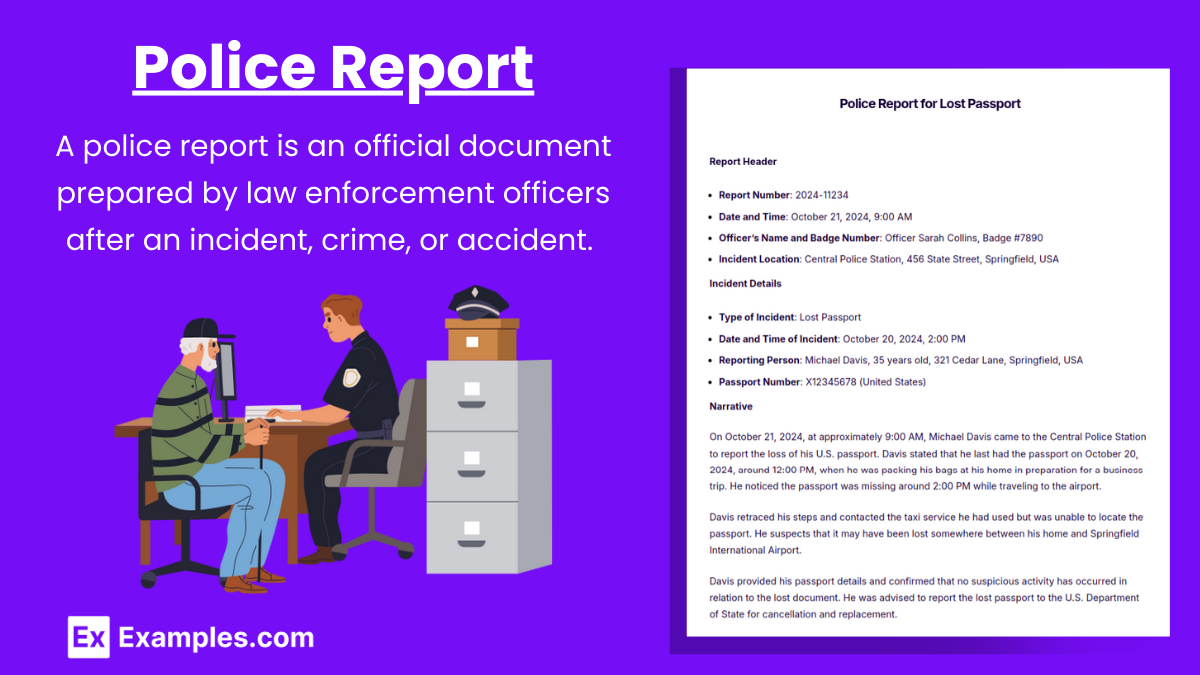15+ Police Report Examples to Download
A police report is a formal document created by law enforcement officers to record the details of an incident, such as a crime, accident, or other significant events. It includes essential information such as the date, time, and location of the incident, as well as the identities of the victims, suspects, and witnesses involved. Whether it’s an incident report, accident report, or a witness statement, the police report provides a factual account of the events, supported by evidence collected at the scene. Police reports are vital in legal proceedings, investigations, and insurance claims, ensuring that facts are accurately documented for future reference.
What Is a Police Report?
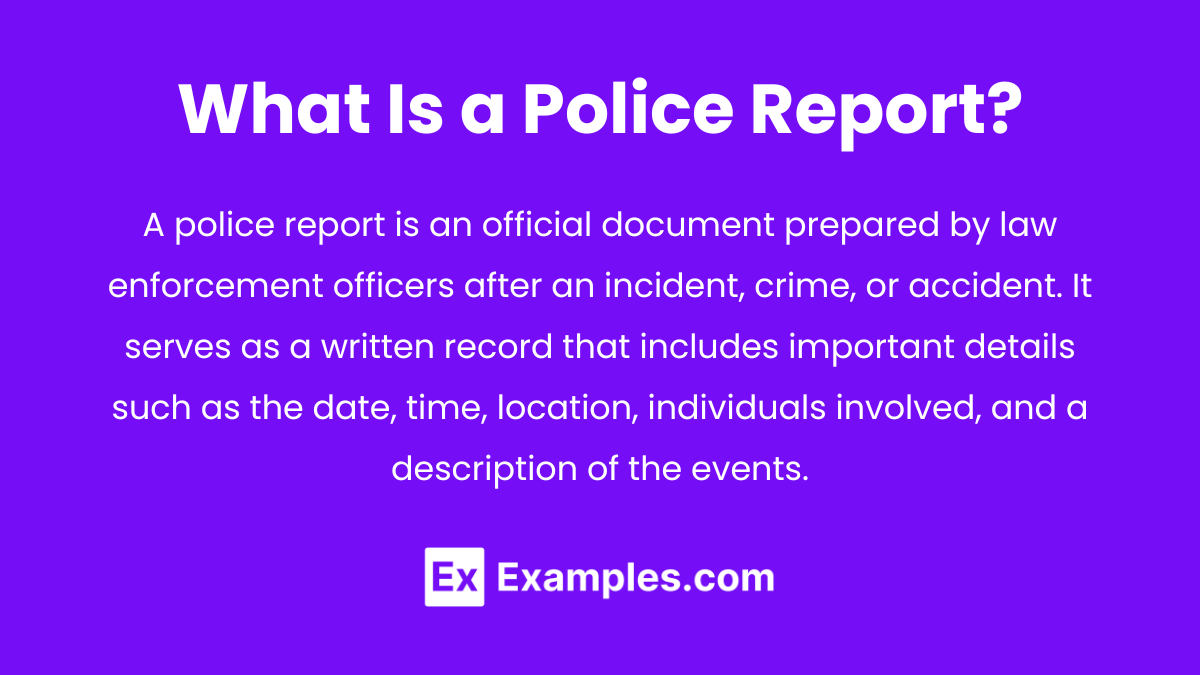
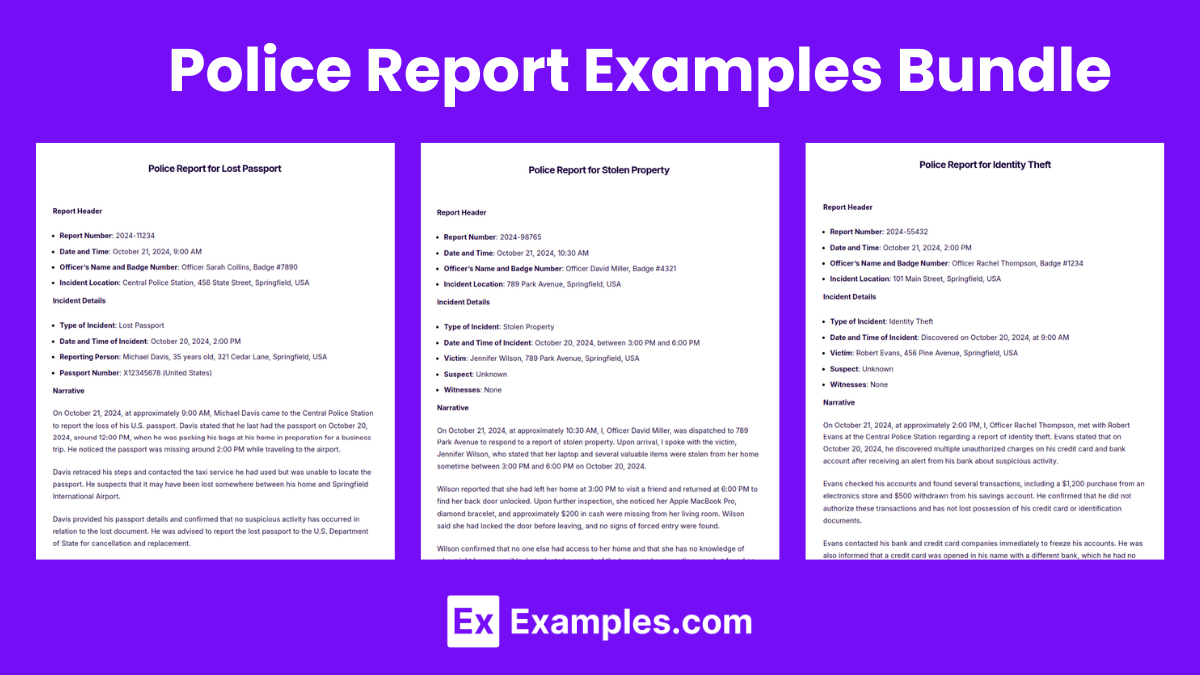
Download Police Report Examples Bundle
Police Report Format
A well-structured police report ensures clarity and accuracy. Below is a typical format for a police report:
Report Header
- Report Number: Unique identification number for the report.
- Date and Time: The exact date and time the report is filed.
- Officer’s Name and Badge Number: The name of the reporting officer and their identification number.
- Incident Location: The address or location where the incident occurred.
Incident Details
- Type of Incident: Crime, accident, or other types of incidents.
- Date and Time of Incident: When the event took place.
- Victims/Involved Parties: Names, addresses, and contact details of victims or parties involved.
- Suspects/Offenders: Names and descriptions (if available) of suspects or offenders.
- Witnesses: Names, contact information, and statements from any witnesses.
Narrative
- Introduction: Briefly state the nature of the incident.
- Detailed Description: A step-by-step account of the incident, including actions taken by officers, responses from involved parties, and evidence collected.
- Officer’s Observations: Any observations made by the officer at the scene (e.g., conditions, demeanor of individuals involved).
Evidence and Property
- Physical Evidence: Description of any items collected, such as weapons, stolen property, or photographs taken.
- Chain of Custody: Information on who handled the evidence and when.
Conclusion/Disposition
- Outcome: What happened as a result of the investigation (e.g., arrests made, charges filed).
- Next Steps: Any follow-up actions required or further investigation needed.
Officer’s Signature and Date
Signature of the reporting officer and the date the report was filed.
Police Report Example
Report Header
- Report Number: 2024-12345
- Date and Time: October 20, 2024, 8:30 PM
- Officer’s Name and Badge Number: Officer John Doe, Badge #5678
- Incident Location: 123 Main Street, Springfield, USA
Incident Details
- Type of Incident: Burglary
- Date and Time of Incident: October 20, 2024, between 6:00 PM and 8:00 PM
- Victim: Sarah Johnson, 123 Main Street, Springfield, USA
- Suspect: Unknown
- Witnesses: James Thompson, 125 Main Street, Springfield, USA
Narrative
On October 20, 2024, at approximately 8:30 PM, I, Officer John Doe, was dispatched to 123 Main Street in response to a reported burglary. Upon arrival, I spoke with the victim, Sarah Johnson, who stated that she had left her residence at 6:00 PM to run errands. When she returned at 8:00 PM, she found the front door slightly ajar and several items missing, including a laptop, jewelry, and cash totaling approximately $1,200.
The victim noticed no signs of forced entry. I canvassed the area and spoke with a neighbor, James Thompson, who reported seeing an unfamiliar vehicle, a black sedan, parked near the house around 7:00 PM. Thompson described the driver as a male wearing a dark hoodie but was unable to provide further details.
I searched the house for additional evidence and took photographs of the scene. No fingerprints or physical evidence were found. The victim was advised to contact her insurance company and follow up with our department if any new information arises.
Evidence and Property
- Stolen Property: 1 Apple MacBook, 1 diamond necklace, $500 in cash.
- Photographs Taken: Yes
- Chain of Custody: Officer John Doe, 8:45 PM, secured photographs.
Conclusion/Disposition
No suspects were identified at the time of the report. The case remains open for further investigation. Follow-up interviews with the victim and the witness will be scheduled in the coming days.
Officer’s Signature and Date
- Officer John Doe, Badge #5678
- October 20, 2024
Police Report for Lost Passport
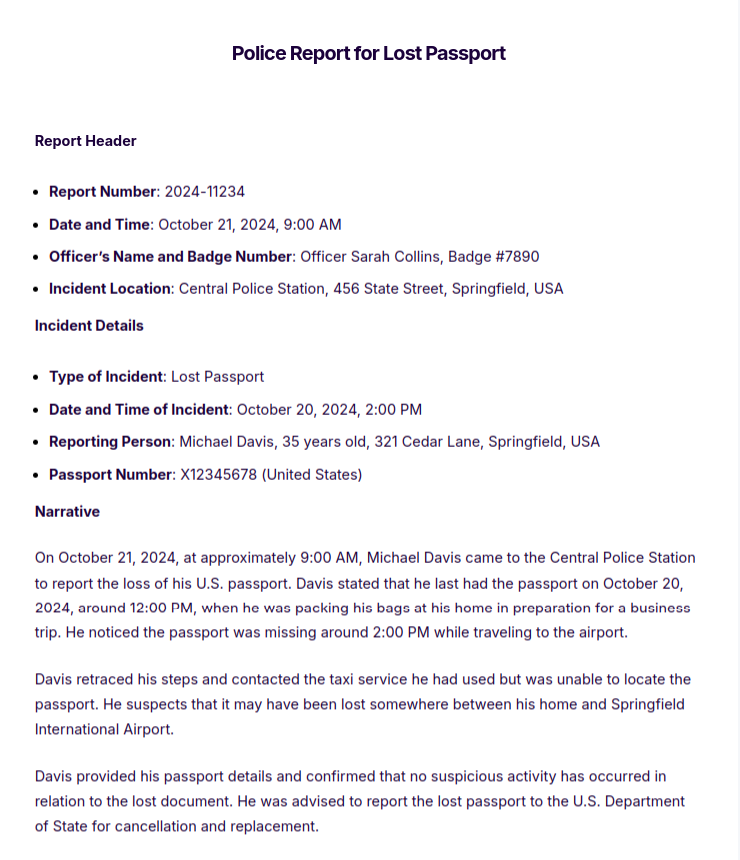
Police Report for Stolen Property
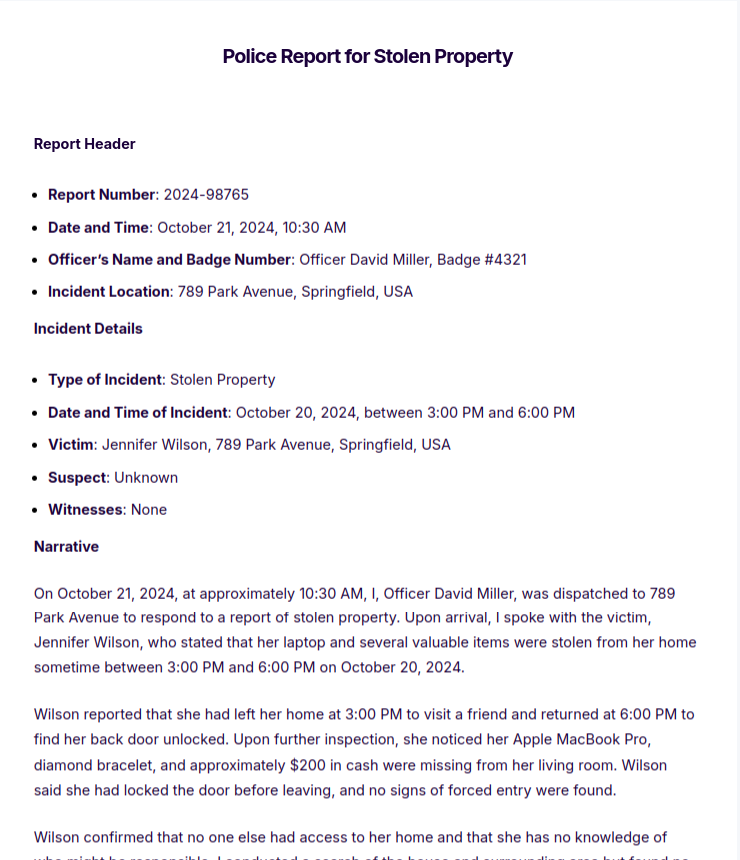
Police Report for Identity Theft
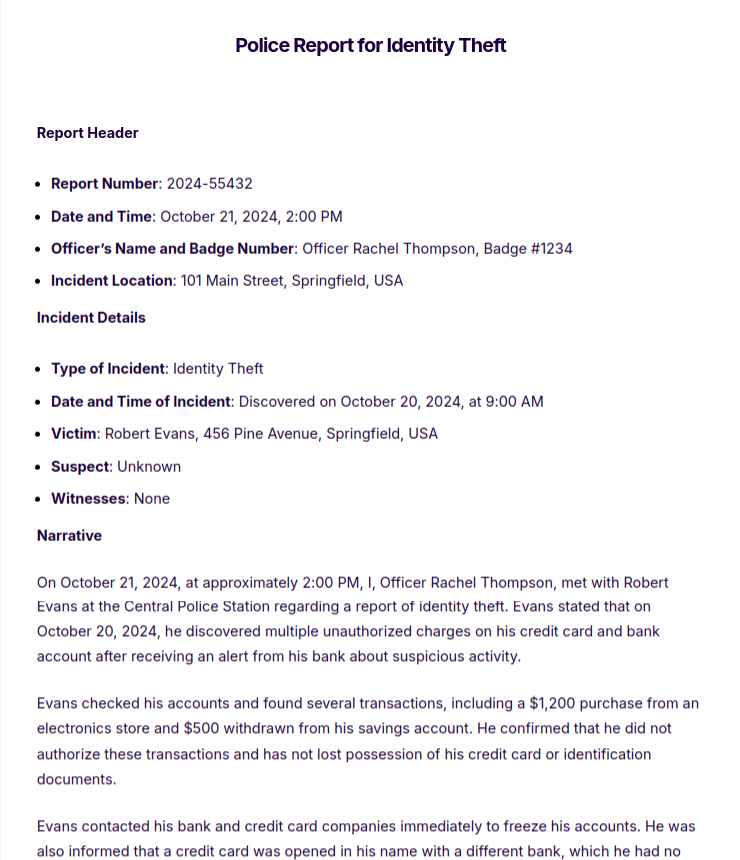
More Police Report Examples and Samples
- Police Report for Harassment
- Police Report to Claim Insurance
- Police Report to Social Services
- Police Report for Missing Person
- Police Report on Domestic Violence
- Police Report on Private Property
- Police Report for Physical Assault
Sample Police Accident Report
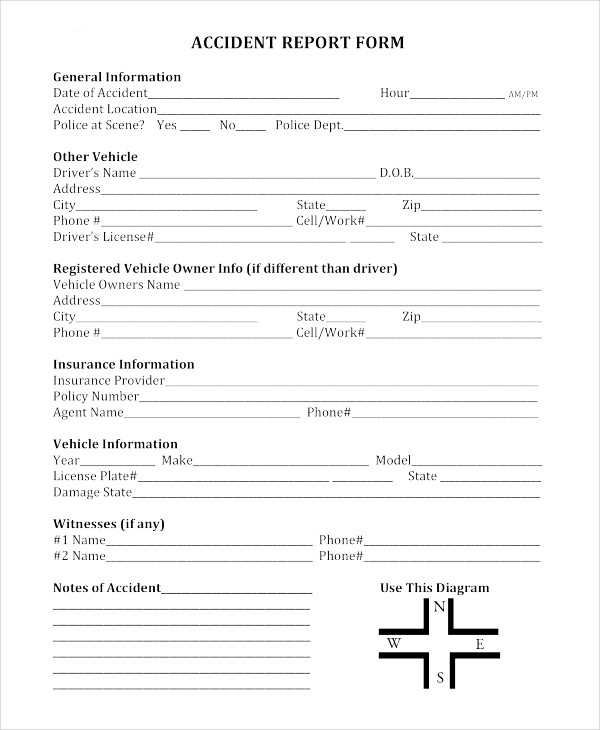
Police File Report
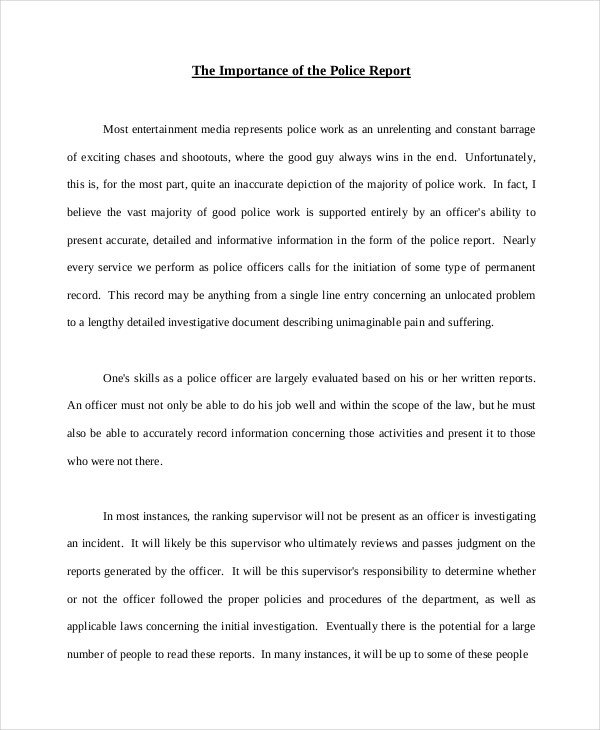
Police Crime Report Example
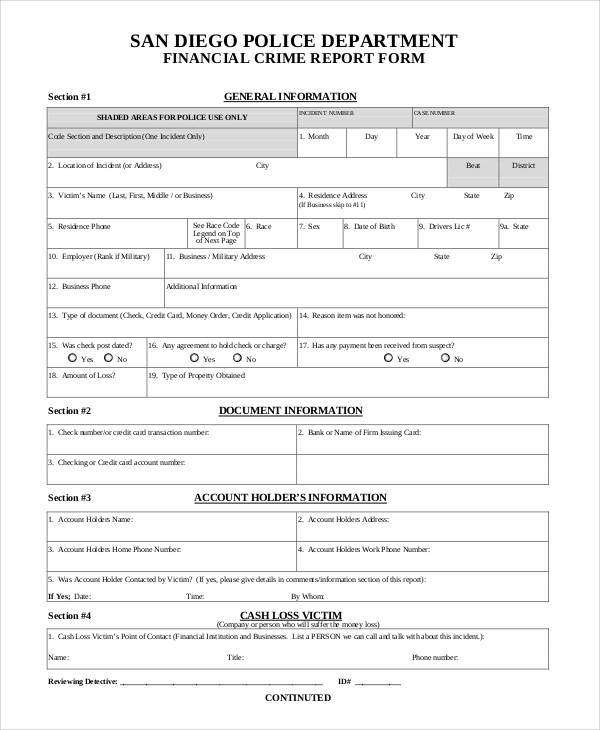
Police Evidence Report in PDF
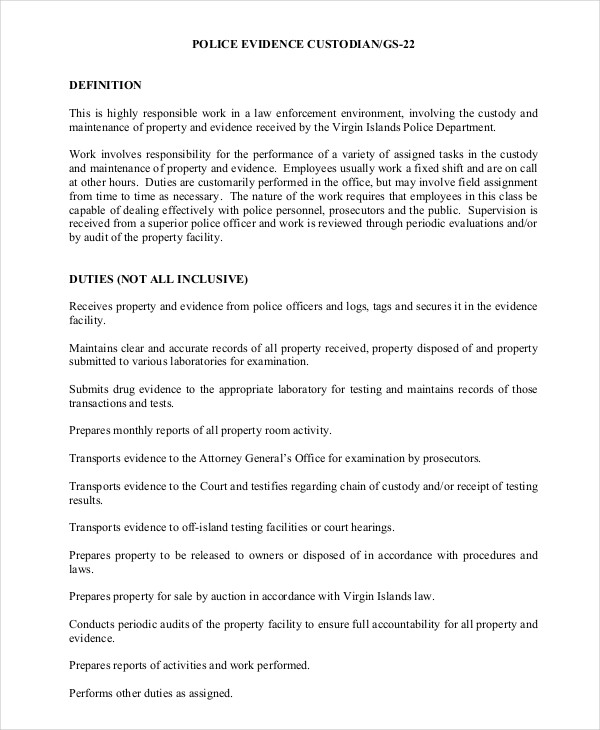
Police Grant Report
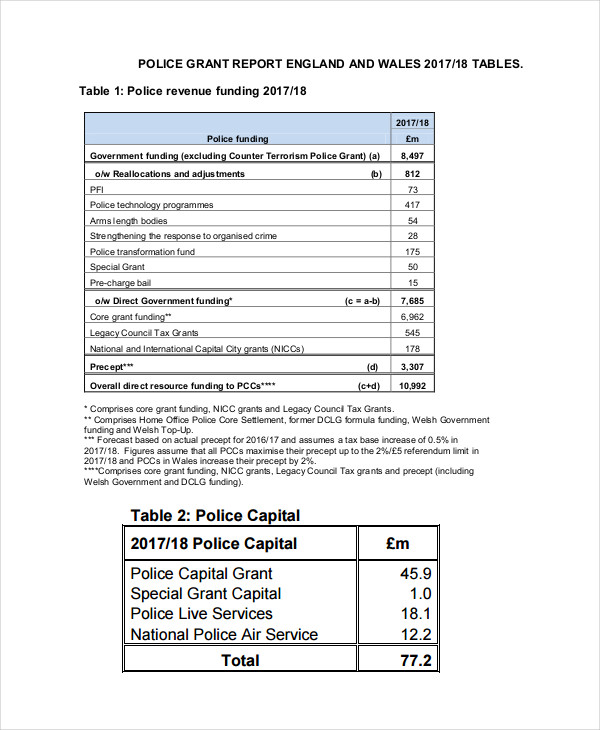
Police Investigation Report
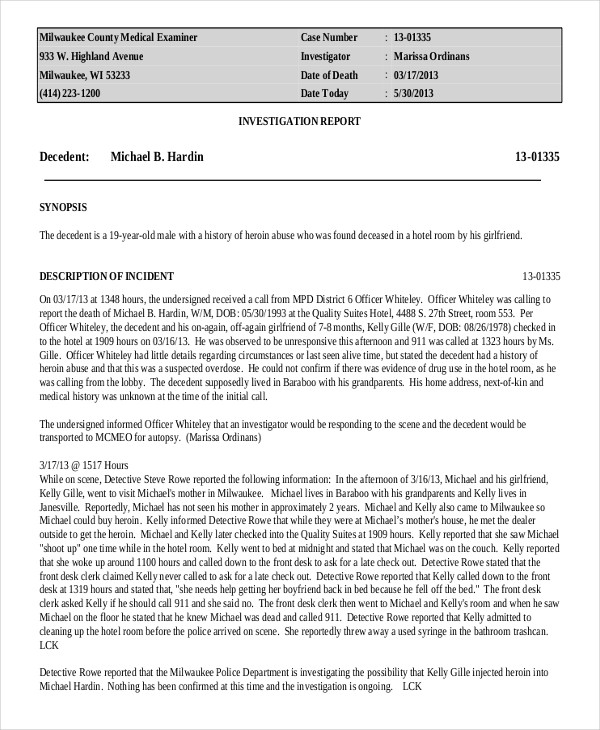
Police Clearance
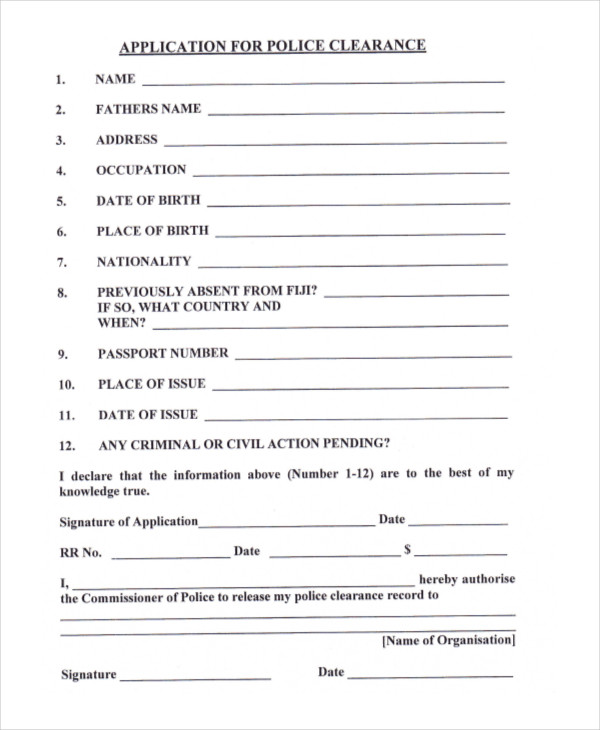
How to Write a Police Report
Writing a police report involves documenting the details of an incident clearly and accurately. A well-structured police report ensures that all relevant information is included for future reference by law enforcement, courts, or other involved parties. Here’s a step-by-step guide to writing an effective police report:
Gather All Relevant Information
Before writing, make sure you have all the key details, including:
Date, time, and location of the incident.
Names and contact information of involved parties (victims, suspects, and witnesses).
Observations made at the scene.
Any physical evidence, photos, or videos collected.Begin with the Report Header
Include the essential identifying details:
Report Number: A unique identifier for the report.
Date and Time of Report: When the report is being written.
Officer’s Name and Badge Number: The officer filing the report.
Incident Location: The address or exact location where the incident occurred.State the Incident Details
Provide a clear summary of the main facts of the incident:
Type of Incident: Define the type of crime or event (e.g., burglary, assault, traffic accident).
Date and Time of Incident: When the incident occurred.
Victim Information: Names and contact details of any victims.
Suspect Information: Names and descriptions of any known suspects.
Witness Information: Names, contact details, and statements from witnesses, if any.Write a Detailed Narrative
The narrative is the heart of the police report. It should be organized, detailed, and chronological. Follow these tips for clarity and thoroughness:
Introduction: Begin with a brief overview of the situation (e.g., “On the afternoon of September 12, 2023, I, Officer John Doe, was dispatched to 123 Main Street to respond to a report of theft.”).
Step-by-Step Account: Explain what happened in the order it occurred: Actions taken by the officer upon arriving at the scene.
Statements from involved parties (victim, suspect, witnesses).
Observations made at the scene (e.g., visible injuries, property damage).
Objective Language: Describe facts as you observed them. Avoid opinions or assumptions.Describe Evidence and Property
Include details of any evidence collected:
Physical Evidence: Note any items recovered, like weapons, clothing, or stolen goods.
Photos/Video: Mention any photos or videos taken at the scene.
Property Description: If applicable, provide details of stolen or damaged property (e.g., serial numbers, descriptions, value).Summarize the Conclusion/Disposition
Clearly state what happened as a result of the incident and investigation:
Arrests/Charges: If an arrest was made, mention who was arrested and on what charges.
Next Steps: Indicate if follow-up action is needed (e.g., further investigation, court appearance).
Case Status: If the case is ongoing, state that the investigation is still open.Sign and Date the Report
The officer must sign and date the report to officially file it. This ensures accountability and records when the report was completed.
Tips for Writing an Effective Police Report
- Be Clear and Concise: Use simple language and short sentences to ensure that the report is easy to understand.
- Focus on Facts: Stick to objective details. Avoid opinions or assumptions, and only include verified information.
- Write Chronologically: Record events in the order they happened to maintain a logical flow of information.
- Be Thorough: Provide all necessary details, including names, times, dates, locations, and descriptions of the people involved and evidence found.
- Use Proper Terminology: Ensure that you use law enforcement terminology correctly but avoid overly technical or confusing language.
- Document Evidence: Include descriptions of any physical evidence, photographs, or witness statements to support your report.
- Proofread for Accuracy: Double-check all details, including spellings of names, addresses, and facts, to avoid errors that could affect the investigation.
- Remain Objective: Always present information without bias or emotion. Your report should remain neutral, focusing on the facts alone.
FAQ’s
When should I file a police report?
You should file a police report if you are a victim of a crime, witness suspicious activity, or are involved in an accident. Common situations include theft, assault, vandalism, car accidents, and lost or stolen property. Filing a police report is also necessary when claiming insurance for damaged or stolen items. In cases of missing persons or personal injury, filing a report helps law enforcement begin an official investigation.
How can I file a police report?
To file a police report, you can visit your local police station and provide details about the incident to an officer. Alternatively, you can call your local police department for non-emergency situations to report the incident over the phone. Some police departments also offer online reporting systems for specific incidents, such as minor thefts or accidents, making it easier for the public to file reports from home.
What information do I need to file a police report?
When filing a police report, you will need to provide personal information such as your name, address, and contact details. Additionally, you should give a clear description of the incident, including the date, time, location, and details about the people involved. If there is any evidence such as photos, videos, or items involved, you should mention that as well. It’s also important to provide details about any lost, stolen, or damaged property.
Can I file a police report after an incident has already occurred?
Yes, you can file a police report even if the incident has already occurred. It’s always recommended to file the report as soon as possible to ensure that the details of the event are fresh in your memory. Prompt reporting also allows law enforcement to begin investigating sooner, which can help with resolving the situation, recovering property, or providing legal support.
How long does it take to process a police report?
The time it takes to process a police report depends on the nature of the incident and the workload of the police department. For minor incidents, such as property damage or lost items, it may take a few days. For more complex cases, such as those involving criminal investigations, the process may take longer as the department may need additional time to investigate, interview witnesses, or collect evidence.


